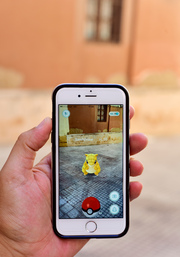What is Augmented Reality and What Are Its Applications?
Augmented reality, AR for short, has emerged as a fascinating technology that blurs the line between the real world and digital world. The goal of this guide is to provide you with an understanding or what augmented reality is. We’ll explore it’s history and then give examples of its various applications for better understanding.
Before diving into the details of Augmented Reality, let’s first explore it’s origins. Over the years, significant advancements in technology and computing power have paved the way for much development in the way of practical AR solutions.
The History of Augmented Reality
Augmented Reality (AR) goes back several decades. Its inception can be traced back to the 1960’s when the concept of combining virtual elements with the real world first emerged. Let’s delve into the key milestones and notable advancements that have shaped the history of augmented reality.
Early Beginnings
The foundations of AR were laid in the 1960s and 1970s when Ivan Sutherland developed the “Sword of Damocles,” an innovative head-mounted display system. Although primitive compared to modern AR, this system paved the way for the idea of overlaying computer-generated graphics onto the real world.
Rise of Virtual Reality (VR)
In the 1980’s and 1990’s, virtual reality gained significant attention, leading to advancements in graphics and display technologies. While Virtual Reality (VR) focused on creating immersive virtual environments, it set the stage for the future development of augmented reality.
AR in Entertainment and Military Applications
The 1990’s witnessed the emergence of early augmented reality applications in entertainment and military sectors. The notable example was the Virtual Fixtures system developed by Louis Rosenberg, which enabled precise control of robotic systems through augmented reality overlays.
Marker-Based AR
The late 1990’s and early 2000’s saw the introduction of marker-based augmented reality systems. These systems used specific markers or visual cues to trigger virtual overlays. This technology enabled early experiments and research in AR, although it was limited by the need for physical markers.
Mobile AR
The advent of smartphones and tablets in the late 2000s revolutionized the field of augmented reality. With the inclusion of cameras, sensors, and powerful processing capabilities, mobile devices became a new platform for AR experiences. Apps like Layar and Wikitude introduced location-based AR, allowing users to access information and virtual content based on their surroundings.
Mainstream Success with Pokémon GO
In 2016, Pokémon GO became a global sensation, introducing augmented reality to millions of people. The game blended real-world locations with virtual Pokémon characters, showcasing the immense potential of AR in the gaming industry and capturing the public’s imagination. While the game as declined since its peak, Pokémon GO is still popular today.
Advancements in Hardware
In recent years, there have been significant advancements in AR hardware. Companies like Microsoft with their HoloLens, Magic Leap, and Apple with their ARKit have developed headsets and platforms that offer more immersive and seamless augmented reality experiences. These advancements have opened new possibilities for industrial applications, design, and visualization.
Integration with Artificial Intelligence
The integration of augmented reality with artificial intelligence has further expanded its capabilities. AI algorithms can now recognize and interpret real-world objects, allowing for more interactive and context-aware AR experiences. This fusion of AR and AI has the potential to revolutionize industries like healthcare, manufacturing, and retail.
From early experiments to widespread adoption, AR has evolved into a versatile tool with applications spanning various fields. With ongoing advancements in technology and growing interest from industries, the future of augmented reality holds even greater potential for transformative experiences and innovation.
Augmented Reality vs Virtual Reality
With Virtual Reality, users need a headset, and their world is strictly virtual and only visible within the visor. Exploration is only possible within the system, not in the real world For students, it’s mainly use to engage learning.
With Augmented Reality, the experience happens within the real world. The tools vary depending on industry, such as a Smartphone in everyday life. In education, AR is immersive and interactive in the real world.
How Does Augmented Reality Work?
To get our heads around augmented reality, we first must grasp the underlying technology. AR systems utilize a combination of hardware and software to overlay digital content onto the real world. This process involves real-time tracking, scene recognition, and rendering techniques to seamlessly integrate virtual elements with the user’s environment.
Types of Augmented Reality
Augmented reality encompasses various forms, each catering to specific needs. Marker-based AR relies on markers or physical objects to trigger virtual overlays. Markerless AR, on the other hand, utilizes computer vision and object recognition to anchor virtual content in the real world. Projection-based AR projects digital content onto real surfaces, while superimposition-based AR replaces or modifies existing real-world objects.
Augmented Reality in Everyday Life
AR is increasingly becoming a part of our daily lives, enhancing various activities. From navigation and travel apps that overlay directions onto the real world, to interior design apps that allow you to visualize furniture in your home. Augmented reality continues to revolutionize how we interact with information and our surroundings.
Augmented Reality in Education
The education system is being transformed as it continues to undergo a paradigm shift due to the integration of augmented reality. AR enables immersive and interactive learning experiences, bringing abstract concepts to life. Students can explore historical events, dissect virtual organisms, or conduct virtual chemistry experiments. This brings a deeper understanding of augmented reality and our engagement with it as humans.
Augmented Reality in Gaming
 The gaming industry has wholeheartedly embraced augmented reality, offering unique and captivating experiences. AR games blend virtual elements with the real world, allowing players to interact with their surroundings in extraordinary ways. As we referred to earlier, from Pokémon GO’s worldwide phenomenon to innovative narrative-driven AR games, the possibilities for gaming in AR continue to expand.
The gaming industry has wholeheartedly embraced augmented reality, offering unique and captivating experiences. AR games blend virtual elements with the real world, allowing players to interact with their surroundings in extraordinary ways. As we referred to earlier, from Pokémon GO’s worldwide phenomenon to innovative narrative-driven AR games, the possibilities for gaming in AR continue to expand.
Augmented Reality in Business
Businesses are leveraging augmented reality to streamline operations, enhance productivity, and improve customer experiences. AR applications are revolutionizing employee training, remote collaboration, and visualization of complex data. Additionally, AR empowers customers with virtual try-on experiences, personalized shopping recommendations, and immersive product demonstrations.
Augmented Reality in Marketing
Marketers are embracing augmented reality as a powerful tool to engage and captivate audiences. AR campaigns enable consumers to interact with products or brands in innovative ways. From virtual fitting rooms that enable try-before-you-buy experiences to AR advertisements that bring static visuals to life, marketers are leveraging AR to create memorable and impactful campaigns.
Augmented Reality in Healthcare
Augmented reality has enabled innovative applications in healthcare. For example, surgeons can now overlay medical images onto patients in real-time, aiding in precise surgeries. AR also enhances medical training, allowing students to practice procedures on virtual patients. Additionally, patient rehabilitation has benefitted greatly thanks to interactive exercises and virtual simulations. Overall, augmented reality is revolutionizing healthcare by improving precision, training, and patient outcomes.
Augmented Reality in the World of Sports
AR provides fans with immersive experiences by overlaying virtual graphics on live broadcasts, offering real-time statistics, replays, and player information. Athletes can benefit from augmented reality in training, analyzing their performance, and enhancing their skills through interactive simulations. Furthermore, referees can make accurate decisions with instant visual overlays. Augmented reality is influencing sports by elevating fan engagement, athlete training, and officiating accuracy.
Augmented Reality Trends to Watch For
The world of augmented reality is evolving rapidly and staying up to date with emerging trends vital to its development and growth. Some notable trends to watch include advancements in AR hardware, such as smart glasses, the integration of AR with artificial intelligence for enhanced contextual understanding, and the rise of location-based augmented reality experiences.
Creating your own augmented reality experiences
You don’t need to be a tech expert to develop your own augmented reality experiences. Various user-friendly AR platforms and development tools are available, allowing individuals and businesses to create customized AR content without extensive coding knowledge. These platforms often provide drag-and-drop interfaces, asset libraries, and intuitive workflows to bring your AR ideas to life.
The Future of Augmented Reality
AR reality holds exciting promise and potential. As technology continues to evolve at a rapid pace, we can anticipate a multitude of exciting advancements in the world of AR. From increasingly immersive and realistic experiences to seamless integration of AR in various industries, the future is brimming with possibilities.
Furthermore, we can look forward to groundbreaking applications of AR that are yet to be imagined, pushing the boundaries of innovation, and transforming the way we perceive and interact with the world around us. Augmented reality is on a trajectory towards a captivating and transformative future.





